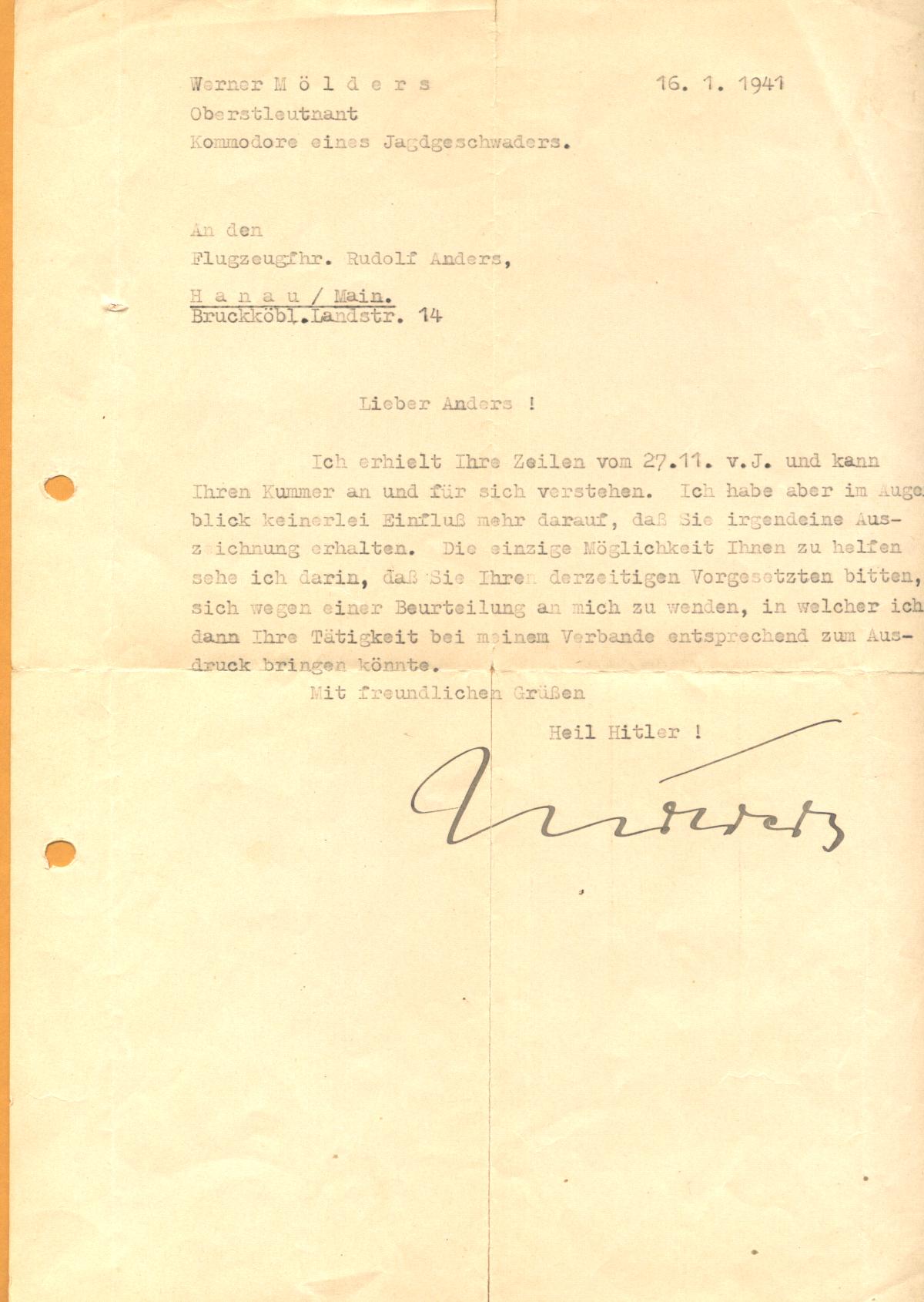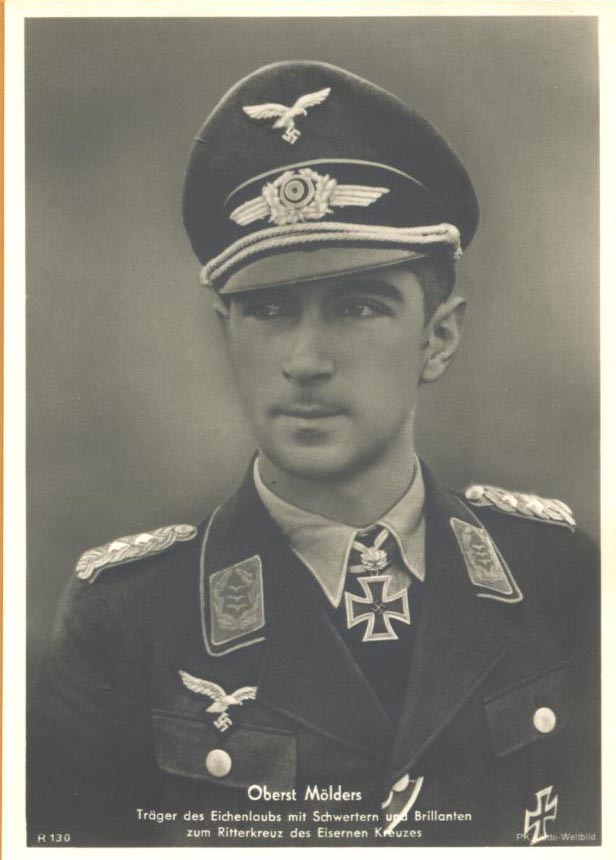

|
~SOLD~MÖLDERS Werner
Oberst
Mölders, Werner
* 18.03.1913 Gelsenkirchen
+ 22.11.1941 bei Breslau
Awarded Knights Cross: 29.05.1940
as: Hauptmann Kommandeur III./JG 53
Awarded Oakleaves as the 2nd Recipient : 21.09.1940 as Major Kommodore JG 51
Awarded Swords as the 2nd Recipient : 22.06.1941 as Oberstleutnant Kommodore JG 51
Awarded Diamonds as the 1st . Recipient: 15.07.1941 as Oberstleutnant
Kommodore JG 51
Werner Mölders (18 March 1913 – 22 November 1941) was a World War II German Luftwaffe pilot and the leading German fighter ace in the Spanish Civil War. Mölders became the first pilot in aviation history to claim 100 aerial victories—that is, 100 aerial combat encounters resulting in the destruction of the enemy aircraft, and was highly decorated for his achievements. He was instrumental in the development of new fighter tactics which led to the finger-four formation. He died in an air crash in which he was a passenger.
Mölders joined the Luftwaffe in 1934 at age 21. In 1938, he volunteered for service in the Condor Legion, which supported General Francisco Franco's Nationalist side in the Spanish Civil War, and shot down 15 aircraft. In World War II, he lost two wingmen in the Battle of France and the Battle of Britain, but shot down 53 enemy aircraft. With his tally standing at 68 victories, Mölders and his unit, the Jagdgeschwader 51 (JG 51), were transferred to the Eastern Front in June 1941 for the opening of Operation Barbarossa. By the end of 22 June 1941, the first day of Barbarossa, he had added another four victories to his tally and a week later, surpassed Manfred von Richthofen's 1918 record of 80 victories. By mid-July, he had 100.
Prevented from flying further combat missions for propaganda reasons, at the age of 28 Mölders was promoted to Oberst, and appointed Inspector General of Fighters. He was inspecting the Luftwaffe units in the Crimea when he was ordered to Berlin to attend the state funeral of Ernst Udet, the World War I flying ace. On the flight to Berlin, the Heinkel He 111 in which he was travelling as a passenger encountered a heavy thunderstorm during which one of the aircraft's engines failed. While attempting to land, the Heinkel crashed at Breslau, killing Mölders and two others. The German Wehrmacht of the Third Reich and the Bundeswehr of the Federal Republic of Germany both honoured him by naming two fighter wings, a destroyer and barracks after him.
Brief bio on this exceptional fighter ace from From Wikipedia, the free encyclopedia
Werner "Vati" Mölders was born on 18 March 1913, at Gelsenkirchen in the Ruhrgebiet. He joined the army in 1931 and served as an officer cadet in the Infantry. In 1934, with the rebirth of the Luftwaffe as a result of Hitler coming to power, Mölders requested a transfer to become a pilot. At his first attempt to join the Luftwaffe, he was declared unfit for flying. He tried again and was accepted for flying training. He was badly afflicted by air sickness but overcame the problem through sheer willpower. On 1 July 1935, Leutnant Mölders was posted to Fliegergruppe Schwerin (later to be redesignated I./StG 162). He was appointed Staffelkapitän of 1./JG 334 (later to be redesignated 1./JG 53) on 15 March 1936. On 1 April 1936, he was transferred to the Schulstaffel of JG 134 to undertake instructing duties. For two years he was an instructor at Wiesbaden. He volunteered for the Condor Legion and arrived by sea in Cadiz on 14 April that year. He took over from Adolf Galland at the head of 3.J/88. During the Spanish conflict he showed considerable qualities not only as a pilot and marksman but also, and especially, as a tactician and organiser. Together with other airmen, in Spain he developed the technique known as the "finger four", or fan, which improved a flight's all-round vision and encouraged the pilots' initiative. Between 15 July and 3 November 1938, he shot down fourteen aircraft: eleven I-16 "Mosca", two Polikarpov I-15 "Chato" and one SB-2 "Katyuska", as well as one unconfirmed I-16 victory, most of these at the controls of the Bf 109 C-1 coded 6-79 "Luchs". He was awarded the Spanienkreuz in Gold mit Schwertern und Brillanten in recognition of his achievements. At the end of the year he returned to Germany as the highest scoring German pilot of the Spanish conflict, with a glowing reputation and a maturity beyond his years and rank. At the beginning of World War II, Mölders was Staffelkapitän of 1./JG 53 "Pik As", based at Wiesbaden-Erbenheim. He became known by those under his command as "Vati" (Daddy) Mölders. He shot down his first aircraft of the Second World War on 21 September 1939, a French Curtiss 75 A fighter. On 1 November he went on to command III./JG 53, also based at Wiesbaden-Erbenheim. On 27 May 1940, after his 20th victory, a French Curtiss 75 A SW of Amiens, he was promoted to Hauptmann and decorated with the Knight's Cross. He was shot down in combat on 5 June 1940, by French ace Sous Lieutenant René Pommier Layragues (6 victories) flying a D.520 of GC II/7 after having scored 25 victories during 128 missions and was taken prisoner. He was liberated two weeks later upon the armistice with France. He returned to Germany to be promoted to Major and given command of JG 51 as Kommodore. On 28 July 1940, during his first flight with his new unit, he succeeded in downing a Spitfire, but his aircraft was then hit by the enemy aircraft. Severely wounded in the legs, Mölders just managed to make an emergency landing at the airfield at Wissant in France. It was not until a month later that he was able to return to combat, most likely flying the Bf 109 E-4 W.Nr. 2404 (photographed on 31 August with 32 victory bars), as well as W.Nr. 3737, (shot down over England while being flown by Hptm Asmus on 25 October, with no stab markings according to the crash report, but 49 victory bars). He quickly brought his score up by downing 28 British fighters during the remainder of the Battle of Britain, including his 40th, a Spitfire over Dungeness, on 20 September, for which he was awarded the Oak Leaves (No. 2) the next day. On 22 October he downed three RAF Hurricanes to become the first Luftwaffe pilot to reach a score of 50 aerial victories. By the end of the Battle of Britain he had a total of 54 victories, and he would add one more before the end of the year.
He continued flying and fighting over the Channel Front until early May, by which time he had brought down an additional 13 British aircraft. On 22 June 1941, the first day of Operation Barbarossa on the Eastern Front, he shot down four Russian aircraft, one I-153 and three SB-2 bombers, his 69th through 72nd victories, and was awarded the Schwertern (No. 2). He was the first pilot to surpass von Richthofen's WW I record score of 80 on 30 June, when he shot down 5 SB-2 bombers to score his 78th to 82nd victories on a day that JG 51 claimed 110 SB-2 and DB-3 bombers. He shot down a further four enemy aircraft on 5 July for his 83rd to 86th victories. On 15 July he became the first pilot in history to record 100 victories and was immediately awarded the Brillanten (No. 1), the first German soldier to be so recognized. He was immediately forbidden to fly combat on the personal orders of Göring. At only 28 years of age, he was promoted to Oberst and appointed Inspector General of Fighters on 7 August. Even though ordered to cease flying combat missions, he continued to do so and achieved several unconfirmed victories over the Crimea. He personally instructed many pilots on how to achieve success, and helped develop the forward air controller concept. On 22 November 1941, he was flying as a passenger in a He 111 from the Crimea to Germany to attend the funeral of Ernst Udet. Landing during a thunderstorm at Breslau the aircraft crashed and Mölders and the pilot were killed. In his memory, on 20 December 1941, JG 51 was bestowed the honor name "Mölders".
He flew a total of some 330 missions during the Second World War, 100 of these on the Eastern Front, during which he shot down a total of 101 aircraft, 33 of these in the East. He also was the top scorer of the Legion Condor in Spain with 14 victories achieved in some 100 missions, and helped develop many of the modern fighter tactics still in use today.
http://www.luftwaffe.cz/molders.html
Signed letter dated 16.1.41 Beautiful signature There is a razor thin separation due to multiple folds over time,running from bottom center of the letter to the word meinem in the last sentence. This does not effect the signature per se. I always use a colored manila envelope as a backdrop when scanning and purposely did not crop it so you can see the color on the left. You can see that there is no color showing were the separation is. Also slight separation at the top center of the letter running to the word Jadgeschwaders. Again separation does not detract from the signature, but I have priced accordingly at a very reasonable price for a famous and sought after signatory period postcard included. Letter pertains to Anders who wrote to Moelders for help in getting recommended for a decoration, but Moelders says he can’t do much unless Anders gets his superior officer to get in touch with Moelders, who will then certify his service with JG 51
Price: $0.00
Please contact us before ordering to confirm availability and shipping costs.
Buy now with your credit card
other ways to buy
|


